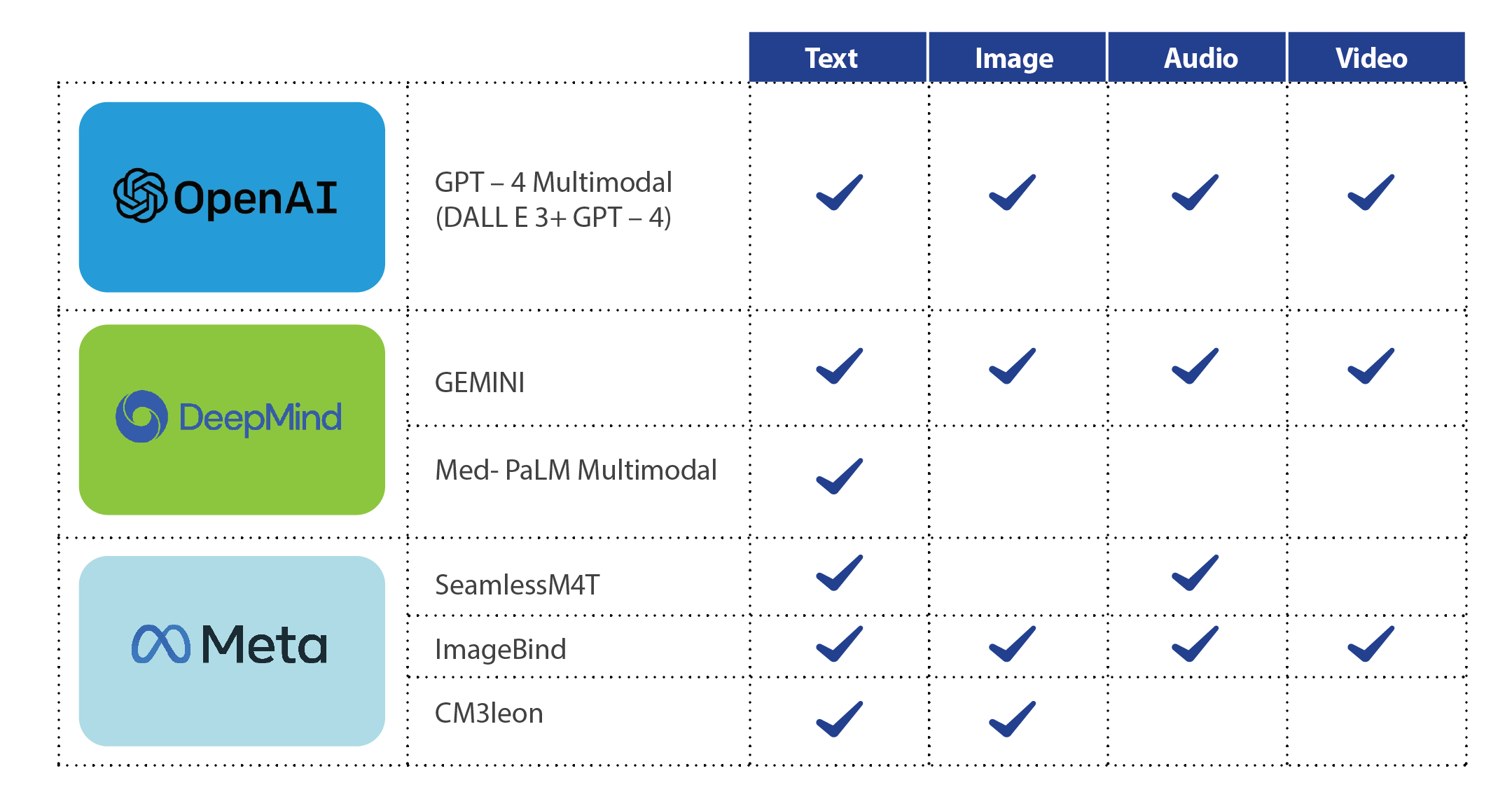The world of media and entertainment is changing faster than you can say “Netflix and chill”. Imagine using video and audio input to create awesome shots and trailers for movies and web series. Sounds like sci-fi, right? Well, not anymore. Thanks to Multimodal AI.
Consumers today want personalised content, digital platforms, and endless choices of OTT and streaming services. Media and Entertainment companies are scrambling to keep up with the demand.
Multimodal AI is like a wizard who can create and understand content in different formats or modes, such as text, images, audio, and video. It uses various AI techniques, such as Natural Language Processing (NLP), Computer Vision, Speech Recognition,Machine Learning, and Large Language Models (LLMs) to work with different types of data and find additional features emerging from combination of data from different sources of information .
From making it easy to understand, to improving accuracy of predictions, efficient resource utilisation to delivering and enhancing User Experience. Media and Entertainment companies can benefit immensely with Multimodal AI approach to streamline business processes.
For Example: When a magic-moment has to be captured by a single video model, it might not pick-up if the scene does not have important features. However, other models like celebrity detection, audio models searching for catchy tunes or scene detections will be able to decide the right fit of the video that needs to be selected for the next stage.
Let’s look at how multi-modal AI can help in generating movie scenes.
Generating movie scenes based on user preferences
Multimodal Inputs
- Video (face detection, celebrity detection, background detection)
- Audio (musical instrument detection, music-note detection, audio energy level detection)
- Text (sub-title, close captioning)
Fusion Module
- Cross-modal attention mechanism to dynamically weigh the importance of text, video, and audio for calculating index to decide priority of selection.
Output Scenes
- Selected movie scenes (Magic Moments)
Discovering Multimodal AI
Interesting use cases and applications
Content Creation, Production and Management
- Video Summarisation
- Key Moments Generation
- Advanced Video Search Capabilities
- Content Recommendation
- Content Moderation
Personalised Experiences
- Interactive Chatbot for better user experience
- Content Localisation- multimodal translation
- Highlights Generation based on user preferences for better engagement
Improve Monetisation
- Targeted Ads
- Content Curation
- Content Matching for Copyright Infringement
- Content Suggestion Engines
Content Creation, Production and Management
Automated Video Editing
Analyse videos and content at a deeper level (including visual, audio and text analysis) and then identify objects, scenes, speech, and text within the videos.
Digital Asset Management (DAM)
Multimodal AI can assist in managing vast collections of digital assets. It can automatically tag and categorise these assets based on their visual and audio content, making it easier to repurpose media assets for various projects. This simplifies content management for media companies, marketing teams, and creative agencies.
Automated Poster Generation
AI can analyse video content to automatically generate posters. This can be displayed best on user profiles for promoting movies or shows. This can improve click-through rates and viewer engagement on OTT platforms.
Explore AIVA
Discover:
- Sports Highlights and Video Summaries
- Virtual Product Placement
- Content Processing Automation
- Multimodal AI to generate rich Metadata
Enhanced Video Search Engines
Multimodal AI can enable advanced video search capabilities. Users can search for videos based on tags, spoken keywords, text within videos, or even objects and scenes recognised in video frames, making video content more discoverable.
Analyse User Behaviour and Feedback
Suggest videos based on preferences. Detects and removes inappropriate or harmful content before being published.
Improving Monetisation
Ad Personalisation and Placement
Analyse user data and behaviour to determine which ads are most likely to resonate with a specific viewer leading to higher engagement and conversion.
Enhanced User Engagement for Mobile Apps
In mobile app monetisation, multimodal AI can analyse user interactions, including textual feedback, in-app images, and audio data from user engagement with the app. By understanding user sentiment, preferences, and behaviors, AI can recommend premium features, in-app purchases, or targeted ads that align with user interests.
AI-Powered Chatbots for E-commerce
In e-commerce, multimodal AI chatbots can assist customers by analysing text and visual data, such as product descriptions and images. These chatbots can guide customers to make informed purchase decisions and suggest complementary products, increasing the average order value. Eg. Amazon, Alexa, Shopify are some examples using AI Chatbots.
Cross-Platform Ad Personalisation
Advertisers are deploying multimodal AI to analyse users’ behavior across different platforms, including websites, mobile apps, and social media. For media operators it allows them to deliver highly personalised ads that are optimised for each platform, boosting engagement and conversions.
Content Licensing and Rights Management
Media companies are using multimodal AI to track the usage of their content across the internet, including text, images, and videos. AI algorithms can identify unauthorised usage and enable content creators to monetise these instances through licensing agreements.
The Road Ahead
In my view the epic battle of Multimodal AI has just begun. The race is not just limited to OpenAI or Google, but Meta and Stability AI is also inching towards it.
But there’s a catch. Ethical issues, data privacy, and security will still be important factors to consider as these technologies advance. If done right, multimodal AI will take the media and entertainment industry to a whole new level of creativity and innovation.


